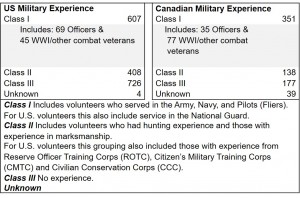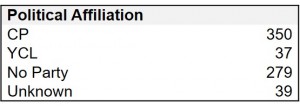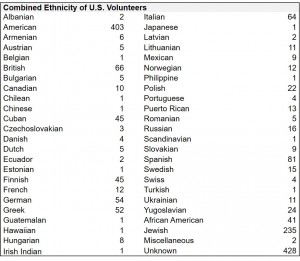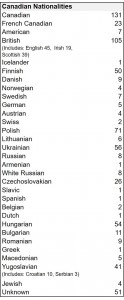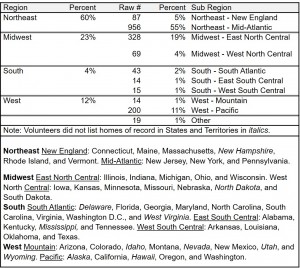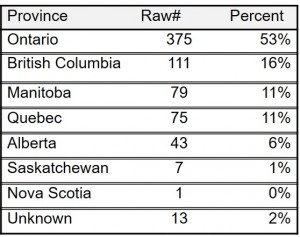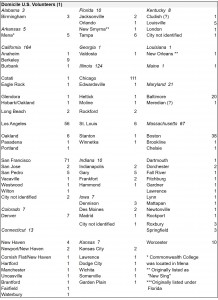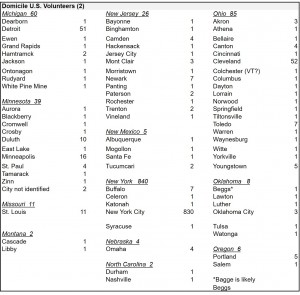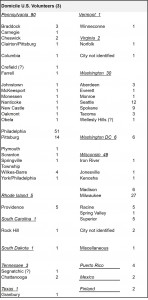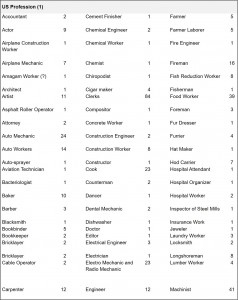An Analysis of American and Canadian Volunteers Compiled by the International Brigades in Spain
The Russian State Archive of Socio-Political History records on U.S. and Canadian volunteers deepens the available insight into the organization and employment of the International Brigades (IB) during the Spanish Civil War. From these records, it is evident that the IB Command was interested in documenting the background of the volunteers. Two documents prepared by the U.S. and Canadian Cadre Services illustrate this interest and provide a snapshot of the demographic composition of the U.S. and Canadian volunteers in the summer of 1937.[i]
Recruitment in North America peaked in the summer of 1937. By the end of July, more than half of all North America volunteers who served in the Spanish Civil War had entered Spain.[ii] The documents referenced in this article provide a demographic picture of the North American volunteers including their ages, military experience, political affiliation, nationality (ethnic composition), domicile (states and cities) and profession. General Report on 1,745 People from the United States is a ten-page document that includes four pages of supplemental material.[iii]General Report on 705 People from Canada is a three-page document providing similar demographic material. Together the documents provide a comprehensive snapshot of U.S. and Canadian volunteers at the height of their strength in numbers.[iv]
Age
The average age of U.S. volunteers was 29, four years younger than the average age for Canadian volunteers. The distribution of U.S. and Canadian volunteers across age groups varied significantly. Volunteers aged seventeen to thirty accounted for 64% of U.S. contingent but only 34% of Canadians. Inversely, volunteers aged thirty-one and over accounted for 55% of Canadian volunteers and only 34% of U.S. volunteers. The study reinforces the common observation that Canadian volunteers as a whole were older than the U.S. volunteers (see Tables 1 and 2).
________________________________________________
NOTE: Click on the individual tables for a larger version.
________________________________________________
Military Experience
More than half of all North American volunteers in the report claimed prior military service or some degree of familiarity with weapons. This is significant because unlike volunteers from European countries, neither Canada nor the United States relied on peacetime universal military conscription to fill the ranks of their armed forces (see Table 3).
Canadians were more likely than their U.S. counterparts to have formal, military-service experience. The report notes that half of the Canadians and slightly more than one-third of U.S. volunteers are Class I, having served in the military or as pilots. Within this group of volunteers 5% of Canadians and 4% of U.S. volunteers served as officers. Three percent of U.S. volunteers and 11% of Canadians were veterans of WWI or of one of the civil wars that erupted at the close of WW I.[v]
A slightly higher percentage of U.S. volunteers were listed in Class II. Class II includes volunteers who possessed applicable military skills. Twenty-three percent of U.S. volunteers were Class II whereas 20% of Canadians were. Many volunteers in both Canada and the U.S. hunted or took part in marksmanship clubs in school.
The higher percentage of Class II U.S. volunteers is likely the result of the inclusion of experience in the Reserve Officers’ Training Corp (ROTC), Citizen’s Military Training Camp (CMTC), and Civilian Conservation Corps (CCC). ROTC and CMTC were programs established to provide the U.S. military with a pool of qualified reserve officers to help command an expanded military in the event of a conflict. Students enrolled in ROTC received a reserve commission upon graduation from college. CMTC offered an alternate route to a commission. Participants in the program trained for a month each summer for three years. Those who completed all three years could apply for a reserve commission. Approximately “370,000” American youths participated in CMTC though few actually completed the three-year requirement.[vi]
The CCC “provided room, board, and medical care as well as wages to young men who worked to enhance the environment.” One of Roosevelt’s New Deal programs, the CCC was intended to be administered jointly by the Labor Department, the Interior Department, the Agriculture Department and the U.S. Army. The first year 250,000 participants enrolled. Due to the sheer size of the program, the U.S. military ended up as the sole administrator for the program. The Army with assistance from the Navy and Marines ran the program for the first couple of years. The program was transitioned to the reserves who ran the program until the outbreak of WWII. CCC men received limited exposure to a military style life. Reservists assumed the administrative duties under a “nominal” civilian director.[vii]
Political Affiliation
The Majority of U.S. and Canadian volunteers were members of the Communist Party (CP) or the Young Communist League (YCL). Volunteers from these organizations comprised 72% of U.S. volunteers and 55% of Canadians. The U.S. list includes nine other political parties. The inclusion of the parties with smaller affiliations were likely included as a nod to The Popular Front coalition. A significant number, 26% of Americans and 40% Canadians, fall under the category of “No Party”. Another nod to the Popular Front was the inclusion of information regarding the volunteer’s involvement in unions or clubs for each entry under the “No Party” classification. The largest representation among these classifications was trade-union membership. 48% of U.S. volunteers and 8% of Canadian volunteers are listed as union members. These numbers have a wide margin for statistical error because relevant data is missing for 44% of US volunteers and 73% of Canadian volunteers listed under “No Party” (see Tables 5 & 6).
Ethnicity
In the original tables, ethnicity was presented as Nationality. Most of the ethnic groups identified are European. The table also lists a small number of South and Central Americans, and a handful of Asian volunteers. Numerous U.S. volunteers were first-generation citizens or recent immigrants retaining strong ethnic ties to their ancestry. Among the Canadians, immigrants, many of whom were recent arrivals, account for approximately 78% of volunteers.[viii]
23% of U.S. volunteers self-identified their ethnicity as “American.” They represented the largest single ethnic grouping. When including African Americans among the U.S. volunteers identifying as “American,” this ethnic group grows to full-quarter of all U.S. volunteers.[ix] The other most frequently listed ethnic groups among the U.S. volunteers were Spanish, British, German, Greek, Finnish, and Cuban which collectively accounted for an additional 23% of U.S. volunteers (see Tables 8 and 10).
Among Canadian volunteers, only 22% were citizens. Immigrants from Britain account for 15% of the total volunteers and are the single largest ethnic group. However, if the British are broken down into subgroups of English, Irish, and Scottish volunteers they individually drop below the percentages of immigrants from some Central and Eastern Europeans. Polish volunteers accounted for 10%, closely followed by Ukrainian and Hungarian immigrants each of which represented 8% of Canadian volunteers. Finnish volunteers accounted for an additional 7%. Together these five groups of immigrants made up 48% of the Canadian volunteers.
It is unusual to the modern eye to see “Jewish” listed as an ethnic grouping. Jewish appears on both the U.S. and Canadian lists. Among the U.S. volunteers 235, or 13% are listed as Jewish.[x] Far fewer Canadians are identified as Jewish volunteers. The four Jewish volunteers listed account for less than 1% of Canadian volunteers. It is likely that additional Jewish Canadian volunteers are counted as citizens or under other ethnic labels.
Domicile
Volunteers came from across North America. U.S. volunteers listed homes in 38 of 48 states and Canadian volunteers listed homes of record in seven of ten provinces (See Tables 15-17 for U.S. and 18 for Canadian). Most volunteers came from larger urban areas. New York City in the Northeast region of the U.S. and Toronto in Canada’s Ontario Province sent their nation’s largest contingents.[xi] Table 12 details the geographic distribution of U.S. volunteers and Table 13 details the Canadian volunteers.
Profession
Information on vocation is available for 70% of U.S. and 50% of Canadian volunteers. The compilers of the list did not attempt to group like vocations from this pool. Both U.S. and Canadian volunteers were predominately from working class backgrounds. The most common vocations listed by U.S. volunteers are seaman 8% and truck driver 6%. Among Canadian volunteers, the most commonly listed vocations are Laborer 11% and Miner (Gold and Coal) 8%. More U. S. volunteers identified their work as white-collar workers and professionals than Canadian volunteers did. Students accounted for 3% of U.S. volunteers but less than 1% of Canadian volunteers.
_____
[i] General Report on 1745 People from the United States and General Report on 705 People from Canada, Российский государственный архив социально-политической истории (Russian State Archive of Socio-Political History) hereafter RGASPI, Fond 545, Opis 6, Delo 455, ll. 0081-0093. The approximate date for these undated documents is derived from comparing them to another document within the Delo, December 1936 to July 20, 1937, (ll. 0094), a one-page list providing a breakdown of political affiliation by state for 1,741 US volunteers. Due to the similarity in numbers evaluated, it is likely that the two studies were completed during the same period. The number of US volunteers listed in December 1936 to July 20, 1937 is only four volunteers less than the number of US volunteers cited in General Report on 1745 People from the United States.
[ii] American veteran Adolph Ross, in his self-published American Volunteers in the Spanish Civil War, stated approximately 2,800 American volunteers served in Spain. Ross’ number includes volunteers who would not have been counted in General Report on 1745 People from the United States. These include volunteers from the American Medical Bureau to Aid Spanish Democracy, volunteers for the Militia who did not transfer to the IB, and Mercenary Pilots. Dr. Michael Petrou in his study Renegades: Canadians in the Spanish Civil War identifies 1,681 Canadians volunteers. Petrou utilized Myron Momryk’s unpublished biographical dictionary of Canadian volunteers along with his own research.
[iii] The supplement breaks out 420 volunteers of the 1,745 though it is not clear why the compiler considered these records significant. The source material for the compiled data is not present in Opis 6, Delo 455 nor in any other Delo thus far reviewed.
[iv] In transcribing the data, I corrected several minor spelling and cataloging errors. The data in the tables is rearranged for clarity. I placed data into alphabetic order to make it easier to locate information.
[v] Canadian and American veterans of the Russian Civil War, the Finnish Civil War, and the Hungarian Revolution served in Spain.
[vi] Coffman, Edward M. The Regulars: The American Army, 1898-1941, Harvard University Press, 2004. p. 235.
[vii] IBID, pp. 242-244. CCC gave unemployed men a chance to earn a living. Pay was $30 per month, almost double the pay of a private in the Army, to do conservation work. The men lived in barracks and worked as part of a 200 man company.
[viii] Peter Carroll, The Odyssey of the Abraham Lincoln Brigade (Stanford: Stanford University Press, 1994), p. 16; Carroll cites a study of 200 American veterans in the 1980s that found 1/3 were born in Europe and came to the US before the age of 15 and 80% had a parent who was born abroad. Michael Petrou, Renegades, Canadians in the Spanish Civil War (Vancouver and Toronto: UBC Press, 2008), p.22. Petrou states that “more than 80% of immigrant volunteers arrived in Canada between 1925 and 1930.”
[ix] If Jewish volunteers, who are all listed as US citizens are added, the total rises to 38%. Another 24% of volunteers’ ethnicity is listed as unknown. Together these four account for 62%.
[x] Jewish volunteers are only identified within the pool of “US citizens.”
[xi] Petrou Renegades, Canadians in the Spanish Civil War, Chapter 1, footnote 34 notes that some volunteers without a permanent address listed Toronto as their home of record because the Central Committee of the Canadian Communist Party was located there and they could have mail held there until their return. It is likely that some US volunteers who listed New York City as their home of record as they were recent arrivals who used a NYC address for their passport application.



